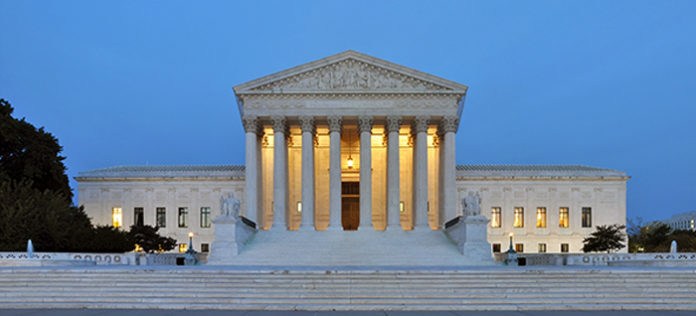

A case about the ability of a company to trademark of a generic-sounding web domain is not, by most measures, considered the most high-profile case the U.S. Supreme Court took this session. But a decision issued Tuesday is consequential to trademark law in the age of the internet and may have protected a host of existing trademarks from cancellation.
In front of the court was whether adding a top-level domain such as “.com” can make an otherwise generic term eligible for protection. The travel website Booking.com had appealed a denial of its trademark by the Patent and Trademark Office in federal district court. That court and the 4th Circuit Court of Appeals ruled in favor of the company, so the patent office appealed to the Supreme Court.
In an almost-unanimous decision, the court declined to to make a bright-line rule that brand names consisting of generic words with attached internet domains cannot get trademark protection. In reaching that conclusion, the court decided based on consumer evidence, people associate “Booking.com” with the specific brand rather than travel booking websites as a general category. During the course of litigation, Booking.com and the courts have relied on survey evidence showing the common consumer association with the name.
“Whether a compound term is generic turns on whether that term, taken as a whole, signifies to consumers a class of goods or services. The courts below determined, and the PTO no longer disputes, that consumers do not in fact perceive the term ‘Booking.com’ that way,” wrote Justice Ruth Bader Ginsburg in the majority opinion.
Ted Davis, a partner at Kilpatrick Townsend & Stockton in Atlanta, said the decision essentially makes the ability to trademark brand names that use everyday words attached to web domains a case-by-case analysis.
“This particular Supreme Court has increasingly preferred flexible standards as opposed to bright-line rules” that guide lower courts to decisions on the back end of litigation, he said.
Ginsburg wrote it doesn’t make sense to apply the logic of an old precedent, known in shorthand as Goodyear, to the new circumstances created by the internet in black-and-white terms.
That case established the premise that adding a generic suffix such as “Company” to a generic word doesn’t create a protectable brand. Because only one entity can have the rights to a particular domain at a time, she wrote, association with a particular website, a “generic.com” name can be a source-identifying characteristic.
The premise of the “Lanham Act is incompatible with an unyielding legal rule that entirely disregards consumer perception,” Ginsburg wrote. “Instead, Goodyear reflects a more modest principle harmonious with Congress’ subsequent enactment: A compound of generic elements is generic if the combination yields no additional meaning to consumers capable of distinguishing the goods or services.”
Justice Stephen Breyer wrote the single dissent. He wrote that because the Booking.com name only informs consumers about the nature of the business, he believes the majority decision doesn’t comport with trademark principles and policy.
He said in his dissent he does believe the Goodyear precedent’s logic grafts directly onto the context of web domains, writing that a compound name made up of a generic term plus a corporate designation is no more than the sum of its parts.
“By making such terms eligible for trademark protection, I fear that today’s decision will lead to a proliferation of ‘generic.com’ marks, granting their owners a monopoly over a zone of useful, easy-to-remember domains,” Breyer wrote. “This result would tend to inhibit, rather than to promote, free competition in online commerce.”
But the majority was not persuaded by the concern from the PTO and Breyer over anticompetitiveness. Ginsburg wrote current law does limit the scope of protection afforded to generic marks because a competitor’s use only infringes on a trademark if it is likely to confuse consumers about the source of a good or service.
“In assessing the likelihood of confusion, courts consider the mark’s distinctiveness. … When a mark incorporates generic or highly descriptive components, consumers are less likely to think that other uses of the common element emanate from the mark’s owner,” Ginsburg wrote.”
Although Breyer’s opinion is the only formal dissent in the ruling, Justice Sonia Sotomayor filed a short concurrence with the majority suggesting she doesn’t believe its reasoning is airtight. Sotomayor put a caveat on the ruling’s reliance on consumer survey evidence, a point that partly echoed Breyer’s dissent.
“Flaws in a specific survey design, or weaknesses inherent in consumer surveys generally, may limit the probative value of surveys in determining whether a particular mark is descriptive or generic in this context,” Sotomayor wrote, though she added, “But I do not read the Court’s opinion to suggest that surveys are the be-all and end-all.”
Davis pointed out Booking.com didn’t win protection in the district court for its name in every type of use. Practically, he said, companies will still need to prove in each instance their mark has taken on the meaning of their brand in consumers’ minds.
“Each claim of distinctiveness for a particular mark should be resolved based on the factual record that the parties to a case put together on that issue.”
— Julia Cardi

